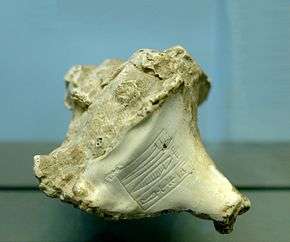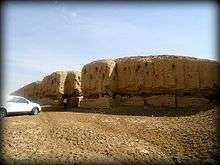Kish (Sumer)
 | |
 Shown within Iraq | |
| Location | Tell al-Uhaymir, Babil Governorate, Iraq |
|---|---|
| Region | Mesopotamia |
| Coordinates | 32°32′25″N 44°36′17″E / 32.54028°N 44.60472°ECoordinates: 32°32′25″N 44°36′17″E / 32.54028°N 44.60472°E |
| Type | Settlement |
| History | |
| Founded | Approximately 3100 BC |
| Periods | Jemdet Nasr to Hellenistic |

Kish (Sumerian: Kiš; transliteration: Kiški; cuneiform: 𒆧𒆠;[1] Akkadian: kiššatu[2]) was an ancient tell (hill city) of Sumer in Mesopotamia, considered to have been located near the modern Tell al-Uhaymir in the Babil Governorate of Iraq, east of Babylon and 80 km south of Baghdad.
History
.svg.png)
Kish was occupied from the Jemdet Nasr period (c. 3100 BC), gaining prominence as one of the pre-eminent powers in the region during the early dynastic period.
The Sumerian king list states that Kish was the first city to have kings following the deluge,[3] beginning with Jushur. Jushur's successor is called Kullassina-bel, but this is actually a sentence in Akkadian meaning "All of them were lord". Thus, some scholars have suggested that this may have been intended to signify the absence of a central authority in Kish for a time. The names of the next nine kings of Kish preceding Etana are all Akkadian words for animals, e.g. Zuqaqip "scorpion". The East Semitic nature of these and other early names associated with Kish reveals that its population had a strong Semitic (Akkadian speaking) component from the dawn of recorded history.[4] Ignace Gelb identified Kish as the center of the earliest East Semitic culture which he calls the Kish civilization.[5]
The twelfth king of Kish appearing on the Sumerian king list, Etana, is noted as "the shepherd, who ascended to heaven and consolidated all the foreign countries". Although his reign has yet to be archaeologically attested, his name is found in later legendary tablets, and Etana is sometimes regarded as the first king and founder of Kish. The twenty-first king of Kish on the list, Enmebaragesi, who is said to have captured the weapons of Elam, is the first name confirmed by archaeological finds from his reign. He is also known through other literary references, in which he and his son Aga of Kish are portrayed as contemporary rivals of Dumuzid, the Fisherman, and Gilgamesh, early rulers of Uruk.
Some early kings of Kish are known through archaeology, but are not named on the King list. These include Utug or Uhub, said to have defeated Hamazi in the earliest days, and Mesilim, who built temples in Adab and Lagash, where he seems to have exercised some control.
The Third Dynasty of Kish is unique in that it begins with a woman, previously a tavern keeper, Kubau, as "king". She was later deified as the goddess Kheba.
Afterwards, although its military and economic power was diminished, Kish retained a strong political and symbolic significance. Just as with Nippur to the south, control of Kish was a prime element in legitimizing dominance over the north of Mesopotamia (Assyria, Subartu). Because of the city's symbolic value, strong rulers later claimed the traditional title "King of Kish", even if they were from Akkad, Ur, Assyria, Isin, Larsa or Babylon. One of the earliest to adopt this title upon subjecting Kish to his empire was King Mesannepada of Ur. [6]A few governors of Kish for other powers in later times are also known, including Ashduniarim and Iawium.[7]
Sargon of Akkad, the founder of the Akkadian Empire, came from the area nearby Kish, called Azupiranu. He would later declare himself the king of Kish, as an attempt to signify his connection to the religiously important area. In Akkadian times the city's patron deity was Zababa (or Zamama), along with his wife, the goddess Inanna.
Kish continued to be occupied through the pre-Babylonian, old Babylonian, Kassite, and Neo-Assyrian Empire and Neo-Babylonian periods, and into classical Seleucid times, before being abandoned.
Archaeology
The Kish archaeological site is actually an oval area roughly 8 by 3 km (5 by 2 mi), transected by the dry former bed of the Euphrates River, encompassing around 40 mounds, the largest being Uhaimir and Ingharra. The most notable mounds are:-
- Tell Uhaimir - believed to be the location of the city of Kish. It means "the red" after the red bricks of the ziggurat there.
- Tell Ingharra - believed to be the location of Hursagkalamma, east of Kish home of a temple of Inanna.[8]
- Tell Khazneh
- Tell el-Bender - held Parthian material
- Mound W - where a number of Neo-Assyrian tablets were discovered
After irregularly excavated tablets began appearing at the beginning of the twentieth century, François Thureau-Dangin identified the site as being Kish. Those tablets ended up in a variety of museums.
Because of it's close proximity to Babylon the site was visited be a number of explorers and travelers in the 1800s, some involving excavation, most notably by the foreman of Hormuzd Rassam who dug there with a crew of 20 men for a number of months. None of this early work was published. A French archaeological team under Henri de Genouillac excavated at Tell Uhaimir between 1912 and 1914, finding some 1,400 Old Babylonian tablets which were distributed to the Istanbul Archaeology Museum and the Louvre. [9] [10] Later, a joint Field Museum and University of Oxford team under Stephen Langdon excavated from 1923 to 1933, with the recovered materials split between Chicago and the Ashmolean Museum at Oxford.[11] [12] [13] [14] [15] [16] [17]
The actual excavations at Tell Uhaimir were led initially by E. MacKay and later by L. C. Watelin. Work on the faunal and flora remains was conducted by Henry Field.[18] [19]
More recently, a Japanese team from the Kokushikan University led by Ken Matsumoto excavated at Tell Uhaimir in 1988, 2000, and 2001. The final season lasted only one week.[20] [21] [22]
Gallery
 An ancient mound at Kish, Babel Governorate, Iraq
An ancient mound at Kish, Babel Governorate, Iraq An ancient mound at the city of Kish, Mesopotamia, Babel Governorate, Iraq
An ancient mound at the city of Kish, Mesopotamia, Babel Governorate, Iraq Pottery fragments, illegal exavations at the ancient city of Kish, Tell al-Uhaymir, Iraq
Pottery fragments, illegal exavations at the ancient city of Kish, Tell al-Uhaymir, Iraq Ancient mound at the city of Kish, Mesopotamia, Babil Governorate, Iraq
Ancient mound at the city of Kish, Mesopotamia, Babil Governorate, Iraq Ruins near the ziggurat of Kish at Tell al-Uhaymir, Mesopotamia, Babel Governorate, Iraq
Ruins near the ziggurat of Kish at Tell al-Uhaymir, Mesopotamia, Babel Governorate, Iraq Ruins near the ziggurat of Kish, Tell al-Uhaymir, Babylon Governorate, Iraq
Ruins near the ziggurat of Kish, Tell al-Uhaymir, Babylon Governorate, Iraq Ruins near the ziggurat of the city of Kish at Tell al-Uhaymir, Babel Governorate, Iraq
Ruins near the ziggurat of the city of Kish at Tell al-Uhaymir, Babel Governorate, Iraq Ruins of the ziggurat of the ancient city of Kish, Tell al-Uhaymir, Mesopotamia, Iraq
Ruins of the ziggurat of the ancient city of Kish, Tell al-Uhaymir, Mesopotamia, Iraq
See also
Notes
- ↑ The Electronic Text Corpus of Sumerian Literature
- ↑ Electronic Pennsylvania Sumerian Dictionary (EPSD)
- ↑ Hall, John Whitney, ed. (2005) [1988]. "The Ancient Near East". History of the World: Earliest Times to the Present Day. John Grayson Kirk. 455 Somerset Avenue, North Dighton, MA 02764, USA: World Publications Group. p. 30. ISBN 1-57215-421-7.
- ↑ Cambridge Ancient History, p. 100
- ↑ Donald P. Hansen, Erica Ehrenberg. Leaving No Stones Unturned: Essays on the Ancient Near East and Egypt in Honor of Donald P. Hansen. p. 133.
- ↑ Albrecht Goetze, Early Kings of Kish, Journal of Cuneiform Studies, vol. 15, no. 3, pp. 105–111, 1961
- ↑ McGuire Gibson, The city and Area of Kish, Field Research Projects, Coconut Grove, 1972
- ↑ Inanna's Descent to the Underworld translation at ETCSL
- ↑ Henri de Genouillac, Premières recherches archéologiques à Kich : mission d'Henri de Genouillac 1911-1912 : rapport sur les travaux et inventaires, fac-similés, dessins, photographies et plans. Tome premier, Paris : Libr. ancienne Edouard Champion, 5, quai Malaquais, 1924
- ↑ Henri de Genouillac, Fouilles françaises d'El-`Akhymer, Champion, 1924-25
- ↑ Stephen Langdon, Excavations at Kish I (1923–1924), 1924
- ↑ Stephen Langdon and L. C. Watelin, Excavations at Kish III (1925–1927), 1930
- ↑ Stephen Langdon and L. C. Watelin, Excavations at Kish IV (1925–1930), 1934
- ↑ Henry Field, The Field Museum-Oxford University expedition to Kish, Mesopotamia, 1923–1929, Chicago, Field Museum of Natural History, 1929
- ↑ P. R. S. Moorey, Kish excavations, 1923–1933 : with a microfiche catalogue of the objects in Oxford excavated by the Oxford-Field Museum, Chicago, Expedition to Kish in Iraq, Clarendon Press, 1978, ISBN 0-19-813191-7
- ↑ S. Langdon and D. B. Harden, Excavations at Kish and Barghuthiat 1933, Iraq, vol. 1, no. 2, pp. 113-136, 1934
- ↑ S. D. Ross, 'The excavations at Kish. With special reference to the conclusions reached in 1928-29', in Journal of The Royal Central Asian Society, vol. 17, iss. 3, pp. 291 - 300, 1930
- ↑ Henry Field, Ancient Wheat and Barley from Kish Mesopotamia, American Anthropologist, New Series, vol. 34, no. 2, pp. 303-309, 1932
- ↑ L. H. Dudley Buxton and D. Talbot Rice, Report on the Human Remains Found at Kish, The Journal of the Royal Anthropological Institute of Great Britain and Ireland, vol. 61, pp. 57-119, 1931
- ↑ K. Matsumoto, Preliminary Report on the Excavations at Kish/Hursagkalama 1988–1989, al-Ra¯fida¯n 12, pp.261-307, 1991
- ↑ K. Matsumoto and H. Oguchi, Excavations at Kish, 2000, al-Rafidan, vol. 23, pp. 1-16, 2002
- ↑ K. Matsumoto and H. Oguchi, News from Kish: The 2001 Japanese Work, al-Rafidan, vol. 25, pp. 1-8, 2004
References
- E. Mackay, Report on the Excavation of the "A" Cemetery at Kish, Mesopotamia, Pt. 1, A Sumerian Palace and the "A" Cemetery, Pt. 2 (Anthropology Memoirs I, 1-2), Chicago: Field Museum,1931
- Nissen, Hans The early history of the ancient Near East, 9000–2000 B.C. (Chicago/London: University of Chicago Press, 1988. ISBN 0-226-58656-1, ISBN 0-226-58658-8) Elizabeth Lutzeir, trans.
- I. J. Gelb, Sargonic Texts in the Ashmolean Museum, Oxford, Materials for the Assyrian Dictionary 5, University of Chicago Press, 1970 ISBN 0-226-62309-2
- McGuire Gibson, The Archaeological uses of Cuneiform Documents: Patterns of Occupation at the City of Kish, Iraq, vol. 34, iss. 2, pp. 113-123, Autumn 1972
- T. Claydon, Kish in the Kassite Period (c. 1650 – 1150 B.C), Iraq, vol. 54, pp. 141–155, 1992
- P. R. S. Moorey, A Re-Consideration of the Excavations on Tell Ingharra (East Kish) 1923-33, Iraq, vol. 28, no. 1, pp. 18–51, 1966
- P. R. S. Moorey, The Terracotta Plaques from Kish and Hursagkalama, c. 1850 to 1650 B.C., Iraq, vol. 37, no. 2, pp. 79–99, 1975
- Norman Yoffee, The Economics of Ritual at Late Old Babylonian Kish, Journal of the Economic and Social History of the Orient, vol. 41, no. 3, pp. 312–343, 1998
- P. R. S. Moorey, The "Plano-Convex Building" at Kish and Early Mesopotamian Palaces, Iraq, vol. 26, no. 2, pp. 83–98, 1964
- P. R. S. Moorey, Cemetery A at Kish: Grave Groups and Chronology, Iraq, vol. 32, no. 2, pp. 86–128, 1970
- Wu Yuhong and Stephanie Dalley, The Origins of the Manana Dynasty at Kish and the Assyrian King List, Iraq, vol. 52, pp. 159–165, 1990
- Seton Lloyd, Back to Ingharra: Some Further Thoughts on the Excavations at East Kish, Iraq, vol. 31, no. 1, pp. 40–48, 1969
- Federico Zaina, Radiocarbon date from Early Dynastic Kish and the stratigraphy and chronology of the YWN Sounding at Tell Ingharr, Iraq, vol. 77(1), pp. 225–234, 2015
- Zaina, F., Craft, Administration and Power in Early Dynastic Mesopotamian Public Buildings. Recovering the Plano-convex Building at Kish, Iraq, Paléorient, vol. 41, p. 177–197, 2015
External links
| Wikimedia Commons has media related to Kish. |